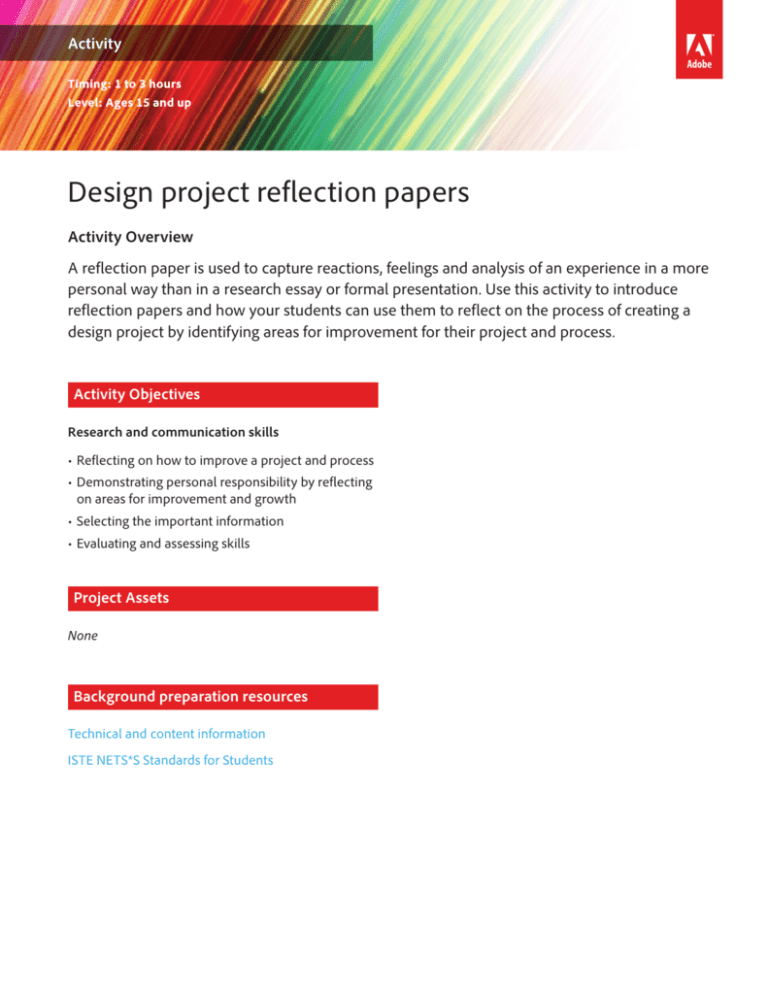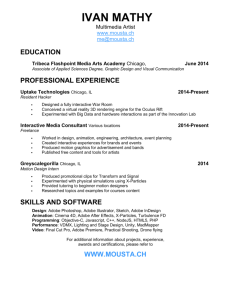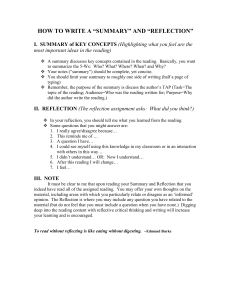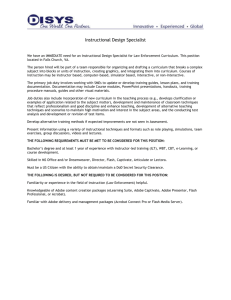
Activity
Timing: 1 to 3 hours
Level: Ages 15 and up
Design project reflection papers
Activity Overview
A reflection paper is used to capture reactions, feelings and analysis of an experience in a more
personal way than in a research essay or formal presentation. Use this activity to introduce
reflection papers and how your students can use them to reflect on the process of creating a
design project by identifying areas for improvement for their project and process.
Activity Objectives
Research and communication skills
•• Reflecting on how to improve a project and process
•• Demonstrating personal responsibility by reflecting
on areas for improvement and growth
•• Selecting the important information
•• Evaluating and assessing skills
Project Assets
None
Background preparation resources
Technical and content information
ISTE NETS*S Standards for Students
Activity Steps
1. Instruct students to write a 1- to 3-page reflection paper about the process of creating their design project,
identifying areas for improvement for their project and process. Depending on the type of project, some
guidelines for the paper may include:
•• Reflect on the design and any re-design decisions they made and a why they made them.
•• Reflect on how they employed design skills they learned in this and previous projects.
•• Reflect on how they employed project management skills they learned in this and previous projects.
•• Reflect on how they employed the technical skills they learned in this and previous projects.
•• Reflect on what skills and techniques they want to learn next to further their knowledge of web design,
graphic design, print production, interactive media design, or video production.
•• Reflect on the team process and identify ways that process could be improved.
•• Reflect on the experience of working with a client, specifically what they learned from the client debriefing.
•• Include evidence of copyright citation and fair use guidelines for assets used in their project.
Assessment:
Reflection
paper
0 – Does not meet
expectations
Absent, incomplete, or
unfocused.
3 – Meets expectations
5 – Exceeds expectations
The reflection paper explains
the design and production
process.
The reflection paper clearly
and concisely explains the
design and production process
and makes relevant and clear
connections to using and
expanding upon the design,
project management, and
technical skills students have
learned in the current and in
previous projects. The
reflection paper identifies
what they want to learn next
to further their skills.
Depending on the project, he
reflection paper also explains:
•• Their experience of working
in a team and ways that
process could be improved.
•• What students learned from
the client debriefing.
Depending on the project, the
reflection paper also clearly
analyzes:
•• Their experience of working
in a team and ways that
process could be improved.
•• What they learned from the
client debriefing.
Design project reflection papers Activity
2
Background preparation resources:
•• For more teaching and learning resources on the topics in this project, search for resources from the community
on the Adobe Education Exchange: http://edex.adobe.com/
ISTE NETS*S Standards for Students
This project is aligned to the ISTE NETS*S Technology Standards. Depending on the subject and content area the
student selects you may research your own state content standards to see how this project aligns to your state
requirements.
ISTE NETS*S: Curriculum and Content Area Standards – NETS for Students
1. Creativity and Innovation
Students demonstrate creative thinking, construct knowledge, and develop innovative products and
processes using technology. Students:
b. create original works as a means of personal and group expression.
d. identify trends and forecast possibilities.
2. Communication and Collaboration
Students use digital media and environments to communicate and work collaboratively, including at a
distance, to support individual learning and contribute to the learning of others. Students:
b. communicate information and ideas effectively to multiple audiences using a variety of media and formats.
4. Critical Thinking, Problem-Solving & Decision-Making
Students use critical thinking skills to plan and conduct research, manage projects, solve problems and make
informed decisions using appropriate digital tools and resources. Students:
a. identify and define authentic problems and significant questions for investigation.
d. use multiple processes and diverse perspectives to explore alternative solutions.
5. Digital Citizenship
Students understand human, cultural, and societal issues related to technology and practice legal and ethical
behavior. Students:
a. advocate and practice safe, legal, and responsible use of information and technology.
b. exhibit positive attitudes toward technology uses that support collaboration, learning, and productivity.
c. demonstrate personal responsibility for lifelong learning.
6. Technology Operations and Concepts
Students demonstrate a sound understanding of technology concepts, systems and operations. Students:
a. understand and use technology systems.
b. select and use applications effectively and productively.
Design project reflection papers Activity
3
For more information
Find more teaching materials for using Adobe
software in your classroom on the Adobe
Education Exchange: http://edex.adobe.com/.
Adobe Systems Incorporated
345 Park Avenue
San Jose, CA 95110-2704
USA
www.adobe.com
Adobe and the Adobe logoare either registered trademarks or
trademarks of Adobe Systems Incorporated in the United States
and/or other countries. All other trademarks
are the property of their respective owners.
© 2013 Adobe Systems Incorporated. All rights reserved.
4






